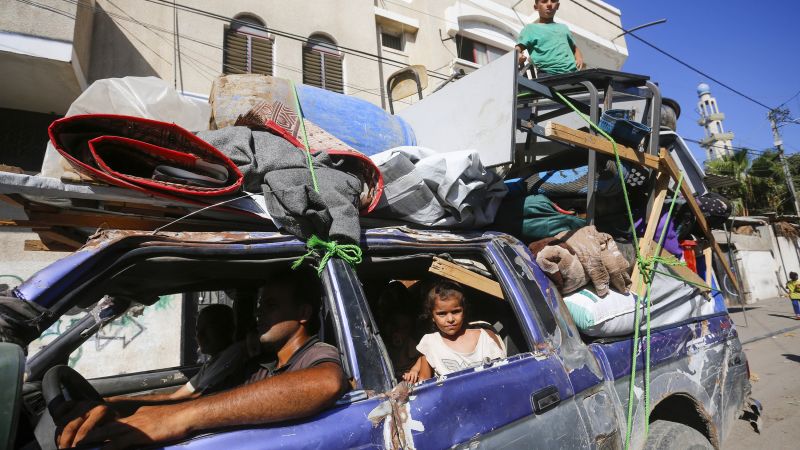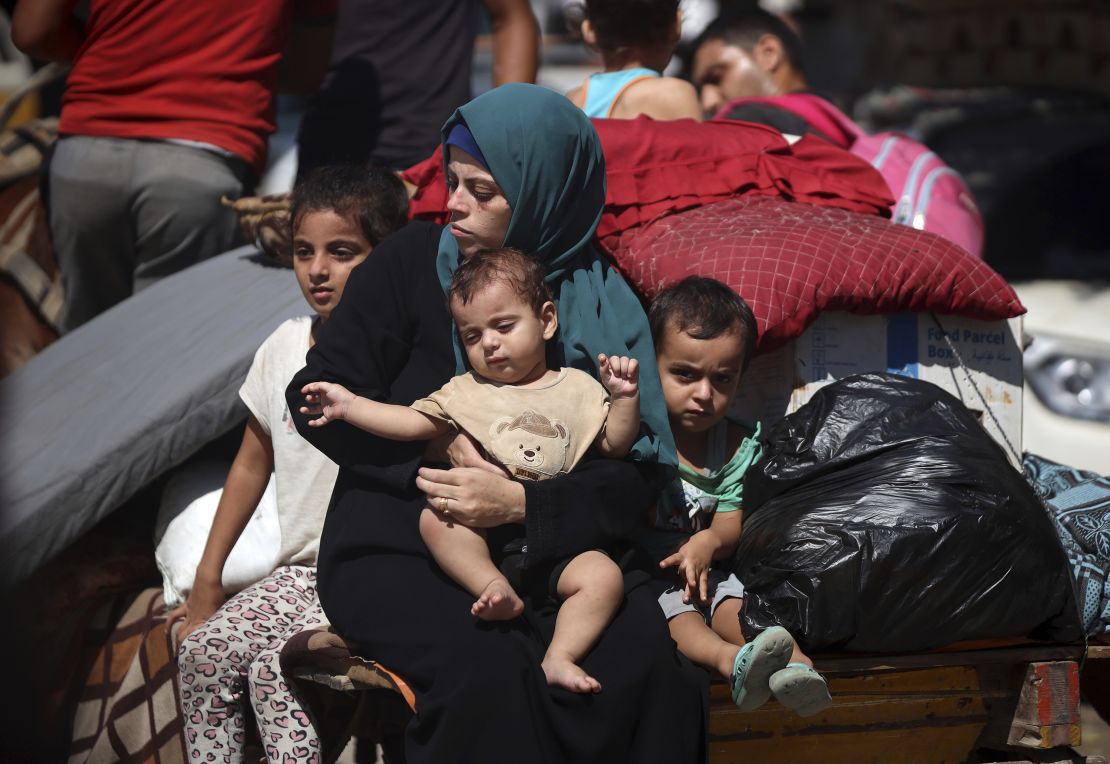
CNN
—
Thousands of Palestinians in Gaza are being forced to flee again after the Israeli military issued new evacuation orders – which experts warn constitute a further encroachment on aid routes and humanitarian areas.
People were seen in video walking or riding donkey carts as they left areas near the central Gaza city of Deir al-Balah. Some were in private cars loaded with belongings, including mattresses, blankets, water bottles and gas. The streets appeared to be littered with leaflets dropped by the IDF stressing the order to evacuate the area.
The IDF has ordered the evacuation of parts of the southern city of Khan Yunis, as well as the Maghazi refugee camp in the central Gaza Strip.
Many of the displaced residents have now been forced to evacuate repeatedly – leaving them in a constant state of displacement, uncertainty and fear that they have nowhere else to flee to.
Displaced people who left Deir al-Balah on Wednesday described feeling overwhelmed with fear, sadness and uncertainty.
“There has been shelling, shooting and quadcopters since this morning east of Deir al-Balah, so we are forced to flee. People are going into the unknown. They have no idea,” said one of the displaced, Mohammed Awad.
“There are no places left to go. There was only Deir al-Balah, and now they are asking us to evacuate Deir al-Balah. I fear that tomorrow they will hold us all on the beach in Deir al-Balah and then exterminate us all,” one elder told CNN.
“After all these displacements, we no longer have the strength to evacuate the place again,” he added.
One of the women on the cart, Umm Alaa, said this was the fourth time she had been forced to evacuate since October last year. “We don’t know where to go. We will look for a place far from this dangerous place. All of Gaza has become dangerous,” she said.
“People are helpless,” said Umm Ismail, a woman with young children. “Why are they fighting us? We are not Hamas, we are simply people staying in our homes. They displaced us not once, but 10 times. Why? What did we do?”
Abu Mohammed Hajjaj, a Gaza City resident who was displaced before, lamented the lack of resources. “Without money to buy a car or even a tent to live in, we don’t know where to go,” he told CNN.
“People are crying and complaining about everything: sickness, hunger, poverty, lack of hygiene, lack of medicine. You search all over Gaza for paracetamol to treat a headache but you can’t find it,” he says.

According to the United Nations Relief and Works Agency for Palestine Refugees (UNRWA), evacuation orders have been issued for about 84% of the Strip since the beginning of the war.
At the same time, the “humanitarian zone” designated by Israel has been steadily shrinking. In the past month alone, the IDF has reduced the area by 38 percent — the remaining area is just over a tenth of Gaza’s total area, according to a CNN analysis.
“Areas that were part of the humanitarian zone are now frontlines,” said Louise Waterridge, a spokeswoman for UNRWA. “Now the people of Gaza are no longer more than a few streets away from the frontline.” She said United Nations News Service.
Evacuation orders have also complicated relief efforts. The UN Office for the Coordination of Humanitarian Affairs reported that parts of a key road, a vital route for humanitarian missions travelling from south to north, were affected by evacuations in Deir al-Balah.
The UN said it has now become “almost impossible” for aid workers to travel along the route, preventing the delivery of much-needed supplies.
Among those fleeing were staff from the international non-profit organisation Doctors Without Borders, also known as Médecins Sans Frontières.
“The continued forced displacement of people is inhumane,” said MSF project coordinator Jacob Grainger in a statement. statement “People have no belongings, no place to go. There is no space to set up tents. Overcrowding, severe water shortages and limited sanitation are all factors that lead to the spread of disease.”
The United Nations estimated last July that up to 1.9 million people in the Strip had been displaced, roughly equivalent to Gaza’s total population of 2.1 million.
Last week, the health ministry in the enclave estimated that more than 40,000 Palestinians have been killed in Gaza since Israel launched its war on Hamas. The figure does not distinguish between combatants and civilians, but the ministry said most of the dead were women and children.
Israel said last month it had killed more than 17,000 fighters in Gaza since the war began. CNN could not independently verify the ministry’s figures.
During the evacuations, American and Israeli leaders continued to discuss a possible ceasefire and the release of the hostages — with President Joe Biden speaking with his Israeli counterpart, Prime Minister Benjamin Netanyahu, on Wednesday, the White House said.
This comes at a crucial time after US Secretary of State Antony Blinken said earlier this week that this may be the last chance to reach an agreement.
CIA Director Bill Burns and other top negotiators are expected to return to Cairo for more high-level talks this week.
The future of the Philadelphi Corridor in southern Gaza – a 14-kilometre (8.7-mile) strip of land along the Egypt-Gaza border, currently controlled by the Israel Defense Forces – is the main point of contention.
Blinken said Tuesday that Israel had agreed to the military withdrawals from Gaza outlined in the latest proposal, despite comments reported by Netanyahu.
Blinken was responding to Israeli media reports that Netanyahu told the top US diplomat that Israel would not leave the Philadelphi Corridor and the Netzarim Corridor, which divides Gaza, “regardless of pressure to do so.”
This story has been updated with additional information.

“Travel specialist. Typical social media scholar. Friend of animals everywhere. Freelance zombie ninja. Twitter buff.”









More Stories
Taiwan is preparing to face strong Typhoon Kung-ri
Israel orders residents of Baalbek, eastern Lebanon, to evacuate
Zelensky: North Korean forces are pushing the war with Russia “beyond the borders”